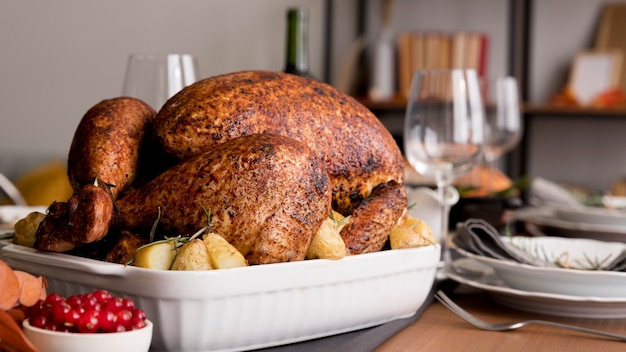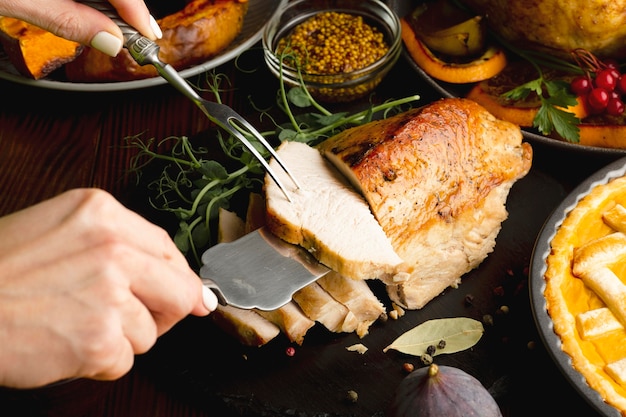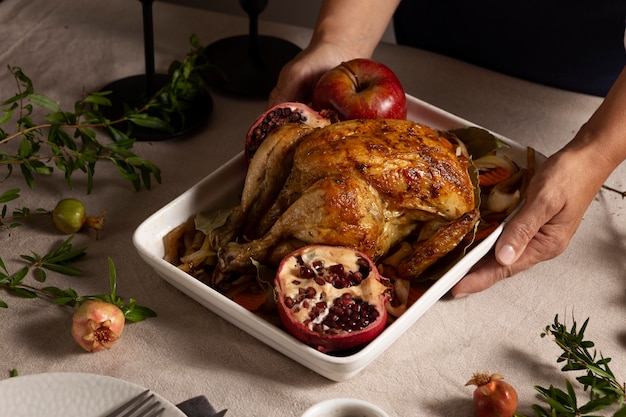Ah, the turkey. The majestic centerpiece of countless festive feasts, the star of thanksgiving dinners, and the symbol of a delicious, home-cooked meal. But getting that bird cooked to perfection can be a bit of a challenge, especially when it comes to those crucial timings. Trust me, I know. I've been there, staring at a hulking 10-pound turkey in my oven, wondering if it's ever going to be done. But fear not! This is my guide to conquering that 10-pound bird and bringing a perfectly cooked turkey to your table.
(Part 1) The Essentials: Setting the Stage for Success

Let's start with the basics. Think of this as a checklist to ensure you're equipped for a successful turkey cook-off. First and foremost, you'll need a roasting pan big enough to accommodate your 10-pound bird. And, don't even think about skipping the meat thermometer. It's your secret weapon for ensuring a perfectly cooked, juicy turkey, and you'll thank me later when you avoid a dry, disappointing bird.
Preparing Your Turkey: A Clean Slate for Flavor
Let's get our turkey ready for the main event! Give it a thorough rinse inside and out, making sure to remove any lingering innards. Imagine you're giving it a luxurious spa treatment, but with water instead of fancy lotions. Next, dry it meticulously with kitchen paper. This might seem like a small detail, but a dry skin will help achieve that beautiful, golden-brown crust we all crave.
Now, the stuffing dilemma. Stuffing or no stuffing? That's the question. Some folks swear by stuffing their turkey, while others prefer to roast it bare. Personally, I'm a stuffing fan, but it does add a little extra complexity to the process. If you're going the stuffing route, choose a recipe specifically designed for cooking inside the turkey, and don't overstuff! Remember, that stuffing needs to cook evenly, and you don't want to create a breeding ground for bacteria. A bit of foresight goes a long way.
Seasoning Your Turkey: Unleashing Flavorful Potential
This is where the fun begins! Time to unleash your culinary creativity. You can go classic with salt and pepper, or dive into a world of herbs and spices. Personally, I like to rub my turkey with a blend of rosemary, thyme, and garlic powder. It adds a beautiful aroma and a subtle depth of flavor.
But before you get too carried away, remember to pat the skin dry again after seasoning. This helps the spices stick and adds a layer of flavor to that coveted crispy skin.
(Part 2) The Big Roast: Bringing the Turkey to Life

The moment you've been waiting for! Preheat your oven to 325°F (160°C), and place your prepped turkey in the roasting pan. Now, here's a tip: a little bit of water at the bottom of the pan can help keep the turkey moist, but it's not a necessity. The goal is to create a beautiful golden-brown crust on the outside while keeping the meat succulent and flavorful.
Roast Time and Temperature: Deciphering the Code
This is where things can get a little nerve-wracking. The general rule of thumb for a 10-pound turkey is 3 to 4 hours in the oven. But that's just a starting point. Factors like your oven's heat, the specific turkey, and whether it's stuffed will all influence the cooking time. This is why that meat thermometer is your best friend.
You're looking for an internal temperature of 165°F (74°C) in the thickest part of the thigh. The area where the thigh meets the body is your target zone. When you insert the thermometer, do it gently. We're not aiming for a meat-stabbing competition. Just a quick, clean insertion to get a precise reading.
Resting and Carving: A Symphony of Flavors
Once your turkey reaches that magical 165°F (74°C), remove it from the oven and let it rest for at least 15 minutes before carving. This allows the juices to redistribute, resulting in a moist and tender turkey. While the turkey is resting, you can get a head start on your side dishes. mashed potatoes, gravy, cranberry sauce – the classic Thanksgiving trio is waiting to be assembled.
When it's time to carve, slice against the grain of the turkey meat. This will make it easier to chew and will enhance the overall texture of your slices. Be patient and take your time. No need to rush the process. You'll end up with beautifully carved slices that will impress everyone at the table.
(Part 3) FAQs: Addressing the Turkey-Cooking Conundrums

Let's face it, even the most experienced cooks have questions when it comes to turkey. Here are answers to some common concerns:
Q1: How long should I roast a 10-pound turkey?
A: The general roasting time for a 10-pound turkey is 3 to 4 hours, but as I mentioned earlier, this can vary significantly. Always use a meat thermometer to ensure the internal temperature reaches 165°F (74°C) in the thickest part of the thigh. That's your ultimate guide to knowing when it's done.
Q2: How do I know if my turkey is done?
A: The meat thermometer is your ultimate guide. Insert it into the thickest part of the thigh, avoiding the bone, and aim for that 165°F (74°C) reading. If you're unsure, pierce the thigh with a fork. If the juices run clear, your turkey is ready.
Q3: What if my turkey is too dry?
A: We've all been there. The fear of dry turkey is real. But there are ways to combat it. One technique is to baste the turkey during cooking with pan drippings. Another trick is to use a turkey roasting bag, which traps moisture and helps keep the bird juicy. Remember, overcooking is the enemy of a moist turkey, so monitor that temperature closely. If your turkey is already dry, a splash of gravy can help to revitalize its moisture levels.
Q4: Can I cook a turkey in a slow cooker?
A: While you can cook a turkey in a slow cooker, it's not ideal for a large bird like a 10-pounder. The slow cooker might not be large enough, and the cooking time can be quite lengthy. However, if you're working with a smaller turkey or a boneless turkey breast, the slow cooker can be a good option.
Q5: What are some good side dishes to serve with turkey?
A: Turkey is incredibly versatile. It pairs well with countless side dishes. The classic Thanksgiving staples like mashed potatoes, gravy, cranberry sauce, and stuffing are always crowd-pleasers. But you can also get creative with roasted vegetables, salads, or even baked sweet potatoes. The options are endless, and the choice is yours!
(Part 4) Beyond the Basics: Tips and Tricks from the Kitchen
You've got the fundamentals down, but let's dive a little deeper into the art of turkey cooking. Here are some tips and tricks that can elevate your roast to the next level.
Brining Your Turkey: The Secret to Supreme Juiciness
Brining is a technique that involves soaking the turkey in a salt-water solution for several hours, or even overnight. It's like giving your turkey a luxurious salt bath! This process helps to lock in moisture, resulting in a succulent and flavorful bird. I'll admit, brining takes a little extra effort, but it's well worth it for that incredible juicy turkey. You can find countless brining recipes online, but a simple solution of salt and water is a classic choice. Just make sure you have a container large enough to accommodate your turkey. The brining time will vary based on the recipe and the size of the bird.
Using a Turkey Roasting Bag: The Moisture-Trapping Champion
A turkey roasting bag is a lifesaver for those who want to guarantee a moist turkey. It traps the steam created during cooking, preventing the bird from drying out. But always choose a bag specifically designed for oven use, and follow the manufacturer's instructions. Keep in mind that using a roasting bag will result in a less crispy skin compared to roasting uncovered.
Roasting the Turkey Upside Down: A Controversial Yet Effective Technique
This technique is a bit unconventional, but it can make a significant difference in achieving a juicy breast. By roasting the turkey upside down, the breast is exposed to the heat for a shorter time, minimizing the risk of dryness. However, this method will result in a less crispy skin on the breast.
To roast upside down, place the turkey in the roasting pan with the breast facing down. Roast for approximately half the total cooking time, then flip it over and continue cooking until it's done.
(Part 5) Troubleshooting: Tackling Common Turkey-Cooking Challenges
Even the most seasoned cooks encounter a few hiccups along the way. Here's how to address some common turkey-cooking challenges.
The Turkey Is Not Browning: Bringing Out the Golden Glow
If your turkey isn't browning as quickly as you'd like, make sure your oven is preheated to the correct temperature. Consider raising the oven rack to bring the turkey closer to the heat source. Another trick is to baste the turkey with pan drippings or melted butter, which helps to encourage even browning.
The Turkey Is Too Dry: Reviving a Dry Bird
Dry turkey is a common issue, often caused by overcooking or inadequate basting. If your turkey is already a bit dry, add some gravy to help revitalize its moisture. To prevent dryness in the future, monitor the temperature closely and avoid overcooking.
The Turkey Is Not Cooking Evenly: Ensuring Consistent Heat Distribution
Uneven cooking can be a symptom of an inconsistent oven. Try rotating the turkey halfway through the cooking process to ensure that all sides are exposed to the heat evenly. You can also adjust the oven rack height to find the ideal position for your particular oven.
(Part 6) The Feast Is Ready!: Enjoying the Fruits of Your Labor
You've done it! Your turkey is cooked to perfection, and it's time to savor your accomplishment. Gather your loved ones, set the table, and let the festivities begin!
Remember, cooking a turkey is more than just a culinary endeavor. It's about creating a shared experience, a gathering of loved ones, a celebration of food, and a time for making lasting memories. So, relax, enjoy the company, and let the warmth of the feast wash over you.
(Part 7) A Personal Touch: More Than Just a Recipe
For me, cooking a turkey goes beyond a simple recipe. It's about bringing people together, sharing stories, and creating a sense of warmth and comfort. It's about making memories, whether it's with family, friends, or even just your roommates. It's about the laughter, the camaraderie, and the shared enjoyment of a delicious meal. And that's what makes the turkey so special.
(Part 8) A Final Word: Embracing the Journey
There you have it! My comprehensive guide to cooking a 10-pound turkey. Remember, it's the journey that matters. Embrace the process, experiment with different techniques, and don't be afraid to make a few mistakes along the way. That's how we learn and grow. And most importantly, have fun! Cooking should be a joy, not a chore.
Now, go forth and conquer your turkey! And don't forget to share your successes (and maybe even your mishaps) with me. I'm always happy to hear from fellow turkey enthusiasts.
Everyone is watching

How to Cook Frozen Lobster Tails Perfectly: A Step-by-Step Guide
RecipesLobster. Just the word conjures up images of lavish meals, special occasions, and a taste of luxury. But let's...

Pigs in a Blanket Cooking Time: How Long to Bake for Perfect Results
RecipesAh, pigs in a blanket. Just the name conjures up images of those delightful little parcels of crispy pastry en...

Pork Fillet Cooking Time: How Long to Cook It Perfectly
RecipesPork fillet, or tenderloin as it's sometimes called, is a real favourite in our house. It's so versatile, and...

The Ultimate Guide to Cooking Delicious Frankfurters
RecipesLet's face it, we all love a good frankfurter. It's a classic, simple, and always satisfying. But let's be rea...

Wolf Meat Recipes: A Guide to Cooking Wild Game
RecipesLet's be honest, you don't see wolf meat at your local butcher shop every day. It's a bit of a wild card, but ...
